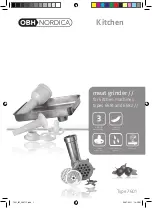
4690 Series
Turbidity systems
7 Calibration
22
IM/4690–EN Rev. A
8. Remove the dry standard, rotate it through 180° and refit
it, ensuring that the NTU value indication (see Figs 7.2 or
7.3) faces the receiver and the locating lug engages
correctly – see Fig. 7.4.
9. Note the reading on the display.
10. If the readings noted at steps 7 and 9 exceed ±5 % of dry
standard value, repeat the procedure from step 4. If
readings are still outside this range, calibrate the sensor.
11. Remove the dry standard and place it in its storage
container.
12. Refit the wiper unit (7998 011 and 012) or wiper plug
(7998 016 and 017).
13. Open the inlet valve and ensure that the flow through the
sensor is 0.5 to 1.5 l min
–1
7.3 Performing a Calibration with a Primary Standard
To prepare the sensor assembly for wet (Formazine) calibration:
1. Close the isolating valve installed upstream of the sensor.
2. Close the sensor inlet valve and open the drain valve.
Allow the sensor to drain.
3. Carefully remove the wiper unit (7998 011 and 012) or the
wiper plug (7998 016 and 017) to aid complete drainage
of the system. When the system is empty, close the drain
valve.
4. Thoroughly dry the flow chamber internally using clean
tissue.
5. Thoroughly clean and dry the emitter and receiver lenses
using clean tissue.
6. Insert the dry calibration standard with the zero NTU
indication (see Figs 7.5 or 7.6, page 23) facing the optical
receiver, ensuring the locating lug engages correctly – see
Fig. 7.7.
Note.
Before performing a wet standard calibration, ensure
a stock formazine solution is available. If a stock solution is
not available, 24 hours must elapse before a
freshly-prepared solution can be used.
Caution.
When removing the wiper unit
do not
put
excessive leverage on the wiper as there is a risk of
bending the wiper arm out of 90 °. On removal of
wiper, check wiper arm has not been bent.
Note.
If condensation forms on the emitter and
receiver lenses, leave the sensor open to enable the
lenses to reach ambient temperature before
attempting calibration.
Note.
Do not touch the light reflecting parts of the
standard.
















































